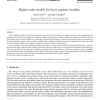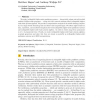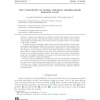8099 search results - page 4 / 1620 » Higher-Order Task Models |
FSS
2008
13 years 9 months ago
2008
A fuzzy random variable is viewed as the imprecise observation of the outcomes in a random experiment. Since randomness and vagueness coexist in the same framework, it seems reaso...
CVPR
2012
IEEE
12 years 1 days ago
2012
IEEE
Motion segmentation based on point trajectories can integrate information of a whole video shot to detect and separate moving objects. Commonly, similarities are defined between ...
ICPR
2006
IEEE
14 years 10 months ago
2006
IEEE
We present a model of a `gas of circles', the ensemble of regions in the image domain consisting of an unknown number of circles with approximately fixed radius and short ran...
FSTTCS
2010
Springer
13 years 7 months ago
2010
Springer
We study (collapsible) higher-order pushdown systems -- theoretically robust and well-studied models of higher-order programs -- along with their natural subclass called (collapsi...
LMCS
2007
13 years 9 months ago
2007
Higher-Order Fixpoint Logic (HFL) is a hybrid of the simply typed λ-calculus and the modal µ-calculus. This makes it a highly expressive temporal logic that is capable of express...



